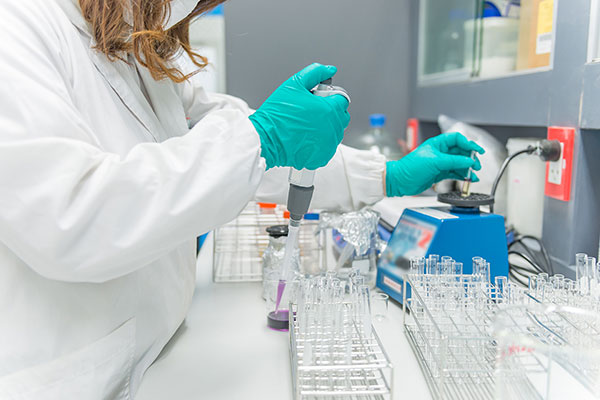Fluorescent Products
Customized Fluorescent Reagents
One-stop Solution for Your Research
BOC Sciences offers a one-stop solution for fluorescent reagents, providing custom synthesis, modification, and large-scale production services. Our comprehensive portfolio includes high-purity fluorescent dyes, probes, and labeling reagents for research and industrial applications, ensuring superior performance and reliability.
Explore More

Background
1. Fluorescent Probes
Fluorescent probes refer to a class of small-molecule biological detection devices that can selectively and continuously convert the chemical information of the analyte into easily measurable fluorescent signals, thereby discriminating an unknown substance. Fluorescent probes are widely used in various detection and labeling, such as determination of metal ions, pesticide residues, biomolecule content, tracer biomolecules, labeling of macromolecules and cellular and subcellular structures. Molecular fluorescent probes are thus classified by applications, including ion probes, polar probes, pH probes, membrane fluorescent probes, cell activity probes, site-specific fluorescent probes, etc.
2. Fluorescent Dyes
Fluorescent dyes are a group of substances that absorb light waves of a certain wavelength and emit light waves with a wavelength greater than that of the absorbed light. Most of them are compounds containing a benzene ring or a heterocyclic ring with a conjugated double bond. Listed below are several commonly used fluorescent dyes.
(1) BODIPY
Compared with fluorescein, rhodamine or cyanine dyes, Bodipy boron fluoride dipyrrole fluorescent dyes have the advantages of higher quantum yield, high molar extinction coefficient, good optical stability and insensitivity to pH, and are widely used in biological labeling, fluorescent probes, and bioimaging.
(2) Rhodamine
Rhodamine are a class of organic fluorescent dyes composed of 3- and 6-amino-substituted xanthene precursors and 9-position carbon atoms substituted aryl groups. Classic rhodamine dyes such as rhodamine B, rhodamine 6G, rhodamine 101, etc.
(3) Fluorescein and its derivatives:
Fluorescein is one of the most common fluorescent dyes. It has a very high molar absorptivity at the argon laser wavelength (488nm) and has strong green fluorescence. The most widely used fluorescein derivatives include fluorescein isothiocyanate (FITC) for labeling proteins (especially antibodies) and carboxyfluorescein (5-FAM) and its isomer 6-FAM,for labeling peptides and oligonucleotides.
(4) Cyanine dyes
Cyanine dyes are the most commonly used type of fluorescent dyes in near-infrared fluorescent dyes, and have significant advantages over conventional visible light dyes. Because autofluorescence of cells and tissues is minimal in the near-infrared wavelengths, near-infrared dyes offer greater specificity and sensitivity when detecting complex biological systems. Cyanine dyes commonly used for biomarkers include Cy3, Cy5, Cy7, etc.
3. Click Chemistry Reagents
Click chemistry is a chemical reaction between pairs of reagents (called click chemistry tools) that react only with each other under mild conditions. According to the type of introduced group, click chemistry reagents are mainly divided into two categories.
(1) Azide Modification Reagent
AmdU (5-azidomethyl-2'-deoxyuridine) can be incorporated into nascent DNA by cellular polymerases. The azide group attached to DNA in this manner can then be modified with an alkyne or cycloalkyne. Azide-PEG2-aldehyde constructs with linker of azide and aliphatic aldehyde moieties. Azide-PEG3-OH functions as bi-functional molecule including PEG3 and OH structure. Biotin PEG3 azide can be labeled with biotin for click chemistry compounds, etc.
(2) Alkynyl modification reagents
Alkyne NHS esters are applied to label biomolecules bearing alkynyl groups for copper-catalyzed click chemistry. Biotin alkynes are reactive affinity tags that can be attached to biomolecules. Azobenzocyclooctyne (DBCO, ADIBO) reagents are used for strain-promoted copper-free click chemistry (spAAC).
4. Specific Fluorescent Stains
Specific fluorescent stains refer to fluorescent reagents with specific functions, which can covalently or non-covalently combine with substances with weak or no fluorescence to form fluorescent complexes, so as to play specific roles.
Resources

- Hoechst Dyes: Definition, Structure, Mechanism and Applications
- Mastering the Spectrum: A Comprehensive Guide to Cy3 and Cy5 Dyes
- Fluorescent Probes: Definition, Structure, Types and Application
- Fluorescent Dyes: Definition, Mechanism, Types and Application
- Coumarin Dyes: Definition, Structure, Benefits, Synthesis and Uses
- Unlocking the Power of Fluorescence Imaging: A Comprehensive Guide
- Cell Imaging: Definitions, Systems, Protocols, Dyes, and Applications
- Lipid Staining: Definition, Principles, Methods, Dyes, and Uses
- Flow Cytometry: Definition, Principles, Protocols, Dyes, and Uses
- Nucleic Acid Staining: Definition, Principles, Dyes, Procedures, and Uses
Online Inquiry

